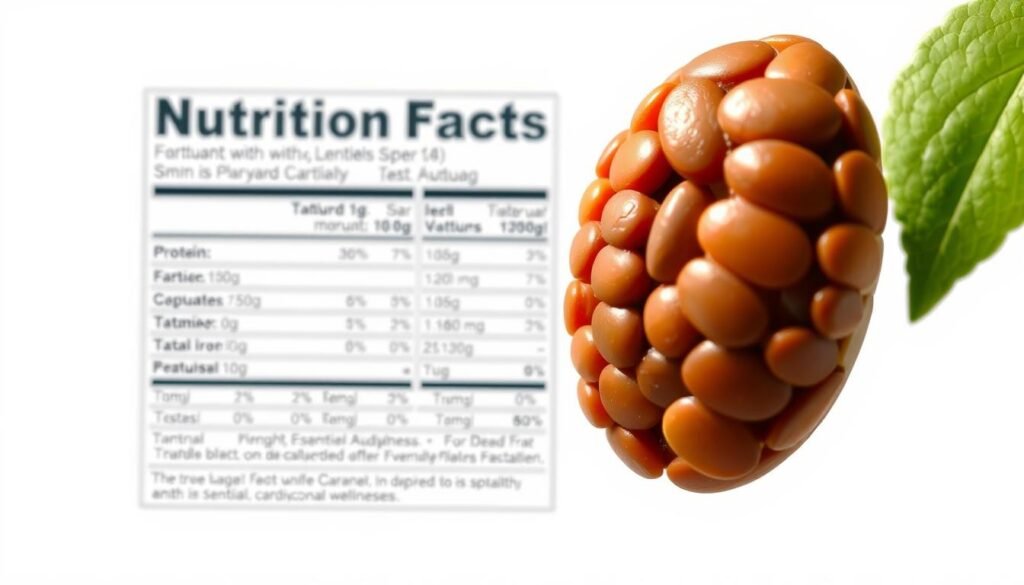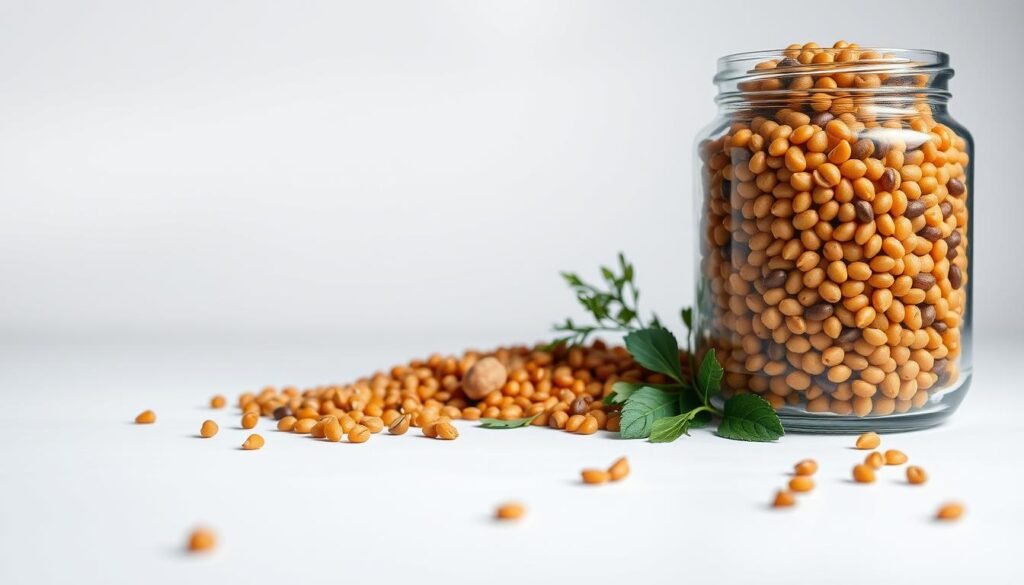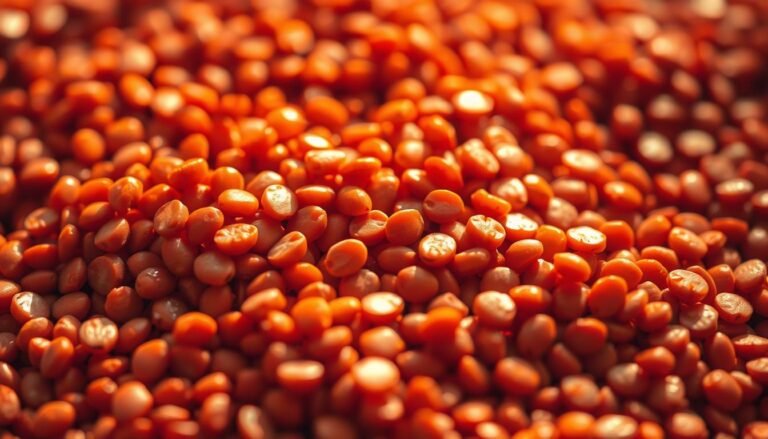Lentils are a nutrient-rich food that has been a staple in many cuisines around the world, particularly in Australia, for centuries. They are an excellent source of protein and fiber, making them a great option for vegetarians and vegans. Lentils are also versatile and can be incorporated into a variety of dishes, from soups to salads.
The nutritional profile of lentils is impressive, with high levels of essential vitamins and minerals. They are rich in iron, potassium, and folate, contributing to their numerous nutritional benefits. By incorporating lentils into your diet, you can experience the positive impact they can have on your overall well-being.
Key Takeaways
- Lentils are rich in protein and fiber.
- They are a versatile ingredient in various cuisines.
- Lentils are packed with essential vitamins and minerals.
- Incorporating lentils can improve overall nutrition.
- Lentils support a healthy diet for vegetarians and vegans.
What Are Lentils? Understanding This Ancient Superfood
As one of the oldest cultivated legumes, lentils have been a vital part of human nutrition for thousands of years. Lentils are a type of legume that is widely consumed globally, particularly for their nutritional benefits. They are small, lens-shaped seeds that come in various colors, including green, brown, red, yellow, and black.
The History and Origin of Lentils
Lentils have a rich history that dates back to ancient times. They are believed to have originated in the Near East, where they were cultivated as early as 13,000 years ago. Lentils were a staple crop in ancient civilizations, including the Egyptians, Greeks, and Romans, who valued them for their nutritional and culinary versatility.
Lentils in Modern Cuisine Around the World
In modern times, lentils continue to be a dietary staple in many parts of the world, particularly in Indian, Middle Eastern, and Mediterranean cuisines. They are prized for their ability to absorb flavors and their nutritional benefits. Lentils are used in a variety of dishes, from soups and stews to salads and curries. Their versatility and health benefits have contributed to their growing popularity worldwide.
Nutritional Profile of Lentils: A Powerhouse of Nutrients
Lentils are a nutritional powerhouse, offering a rich mix of macronutrients and micronutrients. They are an excellent source of essential nutrients, making them a valuable addition to a healthy diet.
Macronutrient Breakdown: Protein, Carbs, and Fiber
Lentils are rich in protein, complex carbohydrates, and dietary fiber. One cup of cooked lentils contains about 18 grams of protein, making them an excellent protein source for vegetarians and vegans. They are also high in complex carbohydrates, which provide sustained energy. Additionally, lentils are a good source of dietary fiber, containing both soluble and insoluble fiber that supports healthy digestion and satiety.
Micronutrient Content: Vitamins and Minerals
Lentils are not only rich in macronutrients but also packed with essential vitamins and minerals. They are a good source of iron, potassium, and folate, among other nutrients.
Essential Minerals in Lentils
Lentils are rich in minerals such as iron, potassium, and zinc. Iron is crucial for healthy red blood cells, potassium helps regulate blood pressure, and zinc supports immune function.
Vitamin Content and Benefits
Lentils are a good source of various vitamins, including folate, vitamin B6, and thiamine. Folate is particularly important for cell division and growth, making it crucial during pregnancy. Vitamin B6 plays a role in many bodily processes, including brain function and the formation of red blood cells.
The Health Benefits of Lentils: Scientific Evidence
Scientific research has unveiled the multifaceted health benefits of lentils, making them a valuable addition to a healthy diet. Lentils are rich in nutrients and have been associated with various health benefits, from heart health to blood sugar management.
Research-Backed Benefits of Regular Lentil Consumption
Studies have consistently shown that regular consumption of lentils can have significant health benefits. Lentils are known to help lower cholesterol levels, which is a major risk factor for heart disease. The high fiber content in lentils contributes to this effect by binding to bile acids and removing them from the body, thereby reducing the amount of cholesterol produced in the liver.
Lentils are also beneficial for blood sugar management. They have a low glycemic index, meaning they are digested slowly and do not cause a rapid spike in blood glucose levels. This makes them an excellent food choice for individuals with diabetes or those at risk of developing diabetes.
How Lentils Compare to Other Legumes
Lentils are part of the legume family, which includes beans, peas, and peanuts. While all legumes are nutritious, lentils have some unique advantages. They are relatively easy to cook compared to some other legumes, requiring less soaking and cooking time. Lentils also have a higher folate content compared to some other legumes, making them a good choice for pregnant women.
In comparison to other legumes, lentils have a similar nutritional profile but with some variations. For instance, lentils are lower in fat compared to peanuts and some beans. They are also rich in essential minerals like iron and potassium, making them a nutritious choice for overall health.
Lentils for Heart Health: Protecting Your Cardiovascular System
Incorporating lentils into your diet can be a significant step towards protecting your cardiovascular system. The nutritional components of lentils play a crucial role in maintaining heart health.
Lowering Cholesterol Levels
Lentils are rich in soluble fiber, which helps in reducing cholesterol levels by binding to bile acids and removing them from the body, thereby reducing the amount of cholesterol produced in the liver. For more information on the health benefits of lentils, you can visit Cleveland Clinic’s article on lentil benefits.
Blood Pressure Regulation and Heart Disease Prevention
The potassium and magnesium content in lentils helps in regulating blood pressure. Potassium counteracts the effects of sodium, while magnesium helps in relaxing blood vessels, improving blood flow, and lowering blood pressure.
The Role of Potassium and Magnesium
Both potassium and magnesium are crucial for heart health. Potassium helps in maintaining a stable blood pressure, while magnesium supports the overall cardiovascular system by ensuring proper heart function and blood vessel relaxation.
Antioxidants and Heart Protection
Lentils are also rich in antioxidants, which help in protecting the heart from damage caused by free radicals. This antioxidant property reduces the risk of heart disease by preventing the oxidation of cholesterol and subsequent plaque formation in arteries.

Blood Sugar Management: Lentils for Diabetes Prevention and Control
Managing blood sugar levels is crucial for overall health, and incorporating lentils into your diet can be a significant step towards achieving this goal. Lentils are known for their nutritional benefits, including their ability to help regulate blood sugar levels.
Lentils have a low glycemic index, which is a measure of how quickly foods raise blood sugar levels. Foods with a low glycemic index, like lentils, are digested more slowly, resulting in a gradual increase in blood sugar.
Glycemic Index of Lentils and Blood Sugar Impact
The glycemic index (GI) is a critical factor in understanding how different foods affect blood sugar levels. Lentils have a low GI, typically ranging from 20 to 30, depending on the type and cooking method. This low GI makes lentils an excellent choice for individuals looking to manage their blood sugar levels. The slow digestion rate of lentils helps to prevent sudden spikes in blood glucose, providing a more stable and sustained energy release.
Benefits of Low GI Foods include reduced insulin resistance, improved glucose metabolism, and a lower risk of developing type 2 diabetes. By incorporating lentils into meals, individuals can potentially mitigate some of the risks associated with high blood sugar levels.
Benefits for People with Diabetes or Prediabetes
For individuals with diabetes or prediabetes, managing blood sugar levels is paramount. Lentils offer several benefits that can aid in this management. The fiber content in lentils not only contributes to their low GI but also helps in slowing down the absorption of sugar into the bloodstream. Additionally, the protein content in lentils can help in regulating blood sugar levels and improving overall glycemic control.
Including lentils in a balanced diet can be a proactive step towards maintaining healthy blood sugar levels. They are versatile and can be incorporated into a variety of dishes, from soups and stews to salads and curries, making them a convenient and nutritious addition to a diabetes management plan.
Digestive Health Benefits: How Lentils Support Your Gut
The digestive benefits of lentils are multifaceted, making them an excellent addition to a gut-friendly diet. Lentils are rich in dietary fiber and contain prebiotic properties that promote a healthy gut microbiome.
Fiber Content and Digestive Function
Lentils are an excellent source of dietary fiber, containing both soluble and insoluble fiber. This fiber content supports digestive health by promoting regular bowel movements and preventing constipation. A high-fiber diet is associated with a reduced risk of diverticulitis and hemorrhoids.
- Promotes regular bowel movements
- Prevents constipation
- Supports healthy gut bacteria
Prebiotic Properties and Gut Microbiome Health
Lentils also possess prebiotic properties that help nourish the good bacteria in the gut, supporting a healthy gut microbiome. This prebiotic effect is crucial for immune system function and overall health.
Resistant Starch in Lentils
Lentils contain resistant starch, a type of carbohydrate that is not fully digested in the small intestine. This resistant starch acts as a prebiotic, feeding the beneficial bacteria in the colon.
Beneficial Bacteria Promotion
The prebiotic properties of lentils promote the growth of beneficial bacteria in the gut. This can lead to a stronger immune system and improved overall health.
Incorporating lentils into your diet can have a significant impact on your digestive health. With their high fiber content and prebiotic properties, lentils support a healthy gut microbiome and promote overall well-being.
Weight Management: How Lentils Can Help You Maintain a Healthy Weight
For those looking to manage their weight effectively, lentils offer a nutritious and filling solution that can be easily integrated into daily meals. Lentils are low in fat and high in fiber, making them very filling and beneficial for weight management.
Satiety and Appetite Control
Lentils are rich in dietary fiber and protein, which are key factors in promoting satiety and controlling appetite. A study published on WebMD highlights the role of fiber-rich foods like lentils in weight management. The complex carbohydrates in lentils digest slowly, keeping you feeling fuller for longer and reducing the likelihood of overeating.
To illustrate the satiety effect of lentils, consider the following comparison:
| Food | Protein Content | Fiber Content | Satiety Index |
|---|---|---|---|
| Lentils | 18g per 100g | 7.9g per 100g | High |
| White Rice | 2.7g per 100g | 0.6g per 100g | Low |
Lentils in Weight Loss Diets
Incorporating lentils into a weight loss diet can be highly beneficial. They are not only filling but also provide essential nutrients, making them a nutritious alternative to high-calorie, low-nutrient foods. A
“diet rich in legumes like lentils can contribute to weight loss and improve overall health.”
This is supported by research indicating that populations consuming high amounts of legumes tend to have lower obesity rates.
To effectively include lentils in a weight loss diet, consider the following tips:
- Add lentils to soups and stews for an extra dose of fiber and protein.
- Use lentils as a base for salads, mixing them with vegetables and a vinaigrette dressing.
- Replace meat with lentils in some meals to reduce calorie intake while maintaining protein levels.
Lentils for Muscle Building and Recovery
Lentils provide a unique combination of nutrients that support muscle building and recovery. They are an excellent source of plant-based protein, essential for muscle repair and growth.
Plant-Based Protein for Athletes and Active Individuals
Lentils are a powerhouse of protein, making them an ideal food for athletes and active individuals. With approximately 18 grams of protein per 1 cup cooked, lentils support muscle development and repair. The health benefits of lentils extend to providing sustained energy and supporting overall athletic performance. Here are some key benefits:
- High protein content for muscle repair
- Rich in complex carbohydrates for sustained energy
- Good source of fiber for digestive health

Essential Amino Acids in Lentils
Lentils contain essential amino acids that are vital for muscle recovery and growth. While they are low in methionine, they can be paired with other foods like grains or nuts to provide a complete amino acid profile. The lentil nutrition facts highlight their richness in:
- Lysine: Important for muscle protein synthesis
- Leucine: Plays a key role in muscle recovery
- Isoleucine: Supports energy production and muscle function
By incorporating lentils into their diet, athletes can support their muscle building and recovery needs effectively.
Types of Lentils and Their Unique Benefits
Exploring the different types of lentils reveals their diverse health benefits and culinary applications. Lentils are not a one-size-fits-all ingredient; they come in various colors and sizes, each with its own nutritional profile and cooking characteristics.
Brown, Green, and French Lentils
Brown lentils are the most commonly consumed type, known for their earthy flavor and firm texture. Green lentils are similar but have a slightly different flavor profile. French lentils, also known as Puy lentils, are renowned for their dark color and peppery taste. These lentils are rich in fiber and protein, making them an excellent choice for heart-healthy diets.
Red and Yellow Lentils
Red and yellow lentils are known for their softer texture and quicker cooking time compared to their brown or green counterparts. They are often used in soups and stews. Red lentils, in particular, break down during cooking, making them ideal for thickening dishes. They are a good source of essential nutrients, including iron and potassium.
Black (Beluga) and Specialty Lentils
Black or Beluga lentils are small, shiny, and hold their shape well after cooking, making them a favorite for salads. Specialty lentils, such as red Beluga or green Puy, offer unique flavors and textures. These lentils are not only nutritious but also add visual appeal to various dishes.
| Type of Lentil | Nutritional Highlights | Culinary Uses |
|---|---|---|
| Brown/Green | High in fiber and protein | Salads, stews, side dishes |
| Red/Yellow | Rich in iron and potassium | Soups, stews, curries |
| Black (Beluga) | High in antioxidants | Salads, side dishes |
Cooking with Lentils: Preparation Tips and Techniques
Cooking lentils is a straightforward process that can be mastered with a few simple techniques. Lentils are a versatile ingredient, and understanding how to prepare them can elevate your meals and provide numerous health benefits, including those related to lentil nutrition facts and the overall health benefits of lentils.
Basic Cooking Methods for Different Lentil Types
Different types of lentils require slightly different cooking methods. For instance, green and brown lentils hold their shape well and are ideal for salads and stews. Red and yellow lentils, on the other hand, break down during cooking and are perfect for soups and purees.
- Green and brown lentils: Boil in water or broth for 20-30 minutes.
- Red and yellow lentils: Simmer in liquid for 15-20 minutes.
Soaking: Necessary or Not?
Soaking lentils can reduce cooking time and improve digestibility. While it’s not always necessary, soaking can be beneficial, especially for larger lentil varieties.
Reducing Cooking Time
Soaking lentils for 30 minutes to an hour can cut down cooking time significantly. This is particularly useful when you’re short on time or prefer your lentils to retain some firmness.
Improving Digestibility
Soaking and rinsing lentils can also help remove some of the indigestible sugars that may cause discomfort. This simple step can make lentils easier to digest, enhancing their health benefits.
By mastering these cooking techniques, you can enjoy lentils in a variety of dishes, from hearty stews to nutritious salads, and reap their nutritional rewards.
Incorporating Lentils into Your Australian Diet
Lentils are a versatile and nutritious addition to any Australian meal plan. With their rich nutritional profile, they offer numerous health benefits, making them an excellent choice for those seeking a healthier lifestyle.
Lentil Availability and Varieties in Australia
Lentils are widely available in Australia, found in most supermarkets and health food stores. Australians can choose from various types, including green, red, and brown lentils, each offering unique textures and flavors for different recipes.
Australian-Inspired Lentil Recipes
Australian cuisine can be beautifully complemented by lentil-based dishes. Consider a hearty lentil soup with bush tomatoes or a lentil salad with grilled Australian lamb. These recipes not only taste great but also provide a nutritious boost.
Seasonal Considerations for Lentil Dishes
Australia’s diverse climate allows for a wide range of seasonal produce that can be paired with lentils. In winter, warm lentil stews are perfect, while in summer, refreshing lentil salads are ideal. This versatility makes lentils a great ingredient year-round.
By incorporating lentils into your diet, you can enjoy their numerous health benefits, from improved heart health to better weight management. With their ease of preparation and versatility in recipes, lentils are a great addition to any Australian kitchen.
Lentils for Special Diets: Vegetarian, Vegan, and Gluten-Free Options
For individuals following vegetarian, vegan, or gluten-free diets, lentils offer a versatile and nutritious solution. Lentils are a valuable component of these special diets, providing essential protein and nutrients.
Lentils as a Meat Substitute
Lentils serve as an excellent meat substitute due to their high protein content and versatility in cooking. They can be used in a variety of dishes, from hearty stews to innovative veggie burgers. The protein in lentils helps to keep you full, making them a satisfying alternative to meat.
Nutritional Highlights:
- High in protein
- Rich in fiber
- Good source of iron and folate
Nutritional Considerations for Plant-Based Diets
While lentils are nutritious, individuals on plant-based diets need to consider certain nutritional aspects to ensure they are getting all the necessary nutrients.
Iron and B12 Supplementation
Iron from plant-based sources like lentils is not as easily absorbed by the body as the iron from animal sources. However, consuming vitamin C-rich foods (like citrus fruits or bell peppers) along with iron-rich foods can enhance absorption. Vitamin B12, crucial for nerve function and red blood cell formation, is primarily found in animal products. Vegans may need to consider B12 supplementation or consume B12-fortified foods.
Protein Combining Strategies
It’s a common misconception that vegetarians and vegans need to “combine proteins” at every meal. In reality, as long as you’re consuming a variety of protein sources throughout the day, you’re likely getting all the essential amino acids your body needs. Lentils can be paired with grains, nuts, or seeds to achieve a complete protein profile.
| Nutrient | Lentils (1 cup cooked) | Daily Value (%) |
|---|---|---|
| Protein | 18g | 36% |
| Fiber | 16g | 64% |
| Iron | 6.6mg | 37% |
Lentils are not only nutritious but also environmentally friendly, making them a great choice for those looking to adopt a more sustainable diet.
Potential Concerns and Considerations When Eating Lentils
While lentils are a nutritious addition to any diet, there are some potential concerns to be aware of. Lentils are generally considered safe and healthy, but like any food, they can have some drawbacks for certain individuals.
Antinutrients in Lentils and How to Minimize Them
Lentils contain antinutrients like phytic acid, lectins, and tannins, which can interfere with nutrient absorption. However, there are ways to minimize their effects. Soaking, sprouting, or boiling lentils can significantly reduce antinutrient levels. For example, soaking lentils overnight before cooking can help reduce phytic acid content.
| Method | Effect on Antinutrients |
|---|---|
| Soaking | Reduces phytic acid and lectins |
| Sprouting | Decreases tannins and phytic acid |
| Boiling | Breaks down lectins and other antinutrients |
Digestive Discomfort and How to Prevent It
Some individuals may experience digestive discomfort after consuming lentils, such as bloating or gas. This is often due to the high fiber and raffinose content. To prevent this, it’s recommended to start with small portions and gradually increase the amount, allowing the gut microbiome to adjust. Additionally, proper cooking and rinsing can help reduce the risk of digestive issues.
Lentils for Different Life Stages: From Childhood to Older Age
From childhood to older age, lentils play a significant role in supporting health and well-being. Lentils are rich in essential nutrients, including protein, fiber, and various vitamins and minerals, making them an excellent addition to diets across different life stages.
Lentils for Children’s Growth and Development
Lentils are an excellent source of nutrients for children, supporting their growth and development. They are rich in protein, which is essential for building and repairing tissues, and fiber, which aids in digestive health. Incorporating lentils into children’s meals can help ensure they receive the necessary nutrients for optimal development.
Benefits for Aging and Longevity
For older adults, lentils offer numerous health benefits that support aging and longevity. They are high in antioxidants and fiber, which can help manage cholesterol levels and support heart health. The nutrient-dense profile of lentils also supports overall health, potentially reducing the risk of chronic diseases associated with aging.
Sustainability Aspects: Why Lentils Are Good for the Planet
In the quest for sustainable eating, lentils stand out as a superfood that’s good for both you and the planet. Lentil farming has a lower environmental impact compared to many other protein sources, making them a sustainable choice.
Environmental Impact of Lentil Farming
Lentil farming is known for its low environmental footprint. It requires less water compared to many other crops and protein sources. Additionally, lentils are legumes that fix nitrogen in the soil, reducing the need for synthetic fertilizers.
Lentils in Sustainable Food Systems
Lentils play a crucial role in sustainable food systems. They are a valuable crop for rotation, improving soil health for subsequent crops. This aspect of lentil farming contributes to more resilient and diverse agricultural ecosystems.
Water Usage Comparison
One of the significant environmental benefits of lentils is their low water requirement. To put this into perspective, here’s a comparison of water usage for different protein sources:
| Protein Source | Water Usage (liters per kg) |
|---|---|
| Lentils | Approx. 1,250 |
| Beef | Approx. 15,000 |
| Chicken | Approx. 4,300 |
Carbon Footprint of Lentils vs. Animal Proteins
Lentils also have a lower carbon footprint compared to animal proteins. The production of lentils generates significantly less greenhouse gas emissions than the production of meat, making lentils a more climate-friendly choice.
By incorporating lentils into your diet, you’re not only improving your health but also contributing to a more sustainable food system. The health benefits of lentils extend beyond personal well-being to environmental sustainability.
Conclusion: Making Lentils a Regular Part of Your Healthy Diet
Incorporating lentils into your diet can have numerous health benefits, from improving heart health to supporting sustainable eating. With their rich nutritional profile, lentils offer a powerhouse of nutrients, including protein, fiber, and essential vitamins and minerals.
The health benefits of lentils are backed by scientific evidence, showcasing their ability to lower cholesterol levels, regulate blood sugar, and support digestive health. Whether you’re looking to manage your weight, build muscle, or simply maintain a healthy lifestyle, lentils are an excellent addition to your diet.
Lentil nutrition facts demonstrate their value as a nutritious and versatile food. Are lentils healthy? Absolutely, and they’re also environmentally friendly, making them a great choice for those looking to adopt sustainable eating habits.
With various types of lentils to choose from and numerous cooking methods, incorporating lentils into your Australian diet is easy and delicious. Make lentils a regular part of your healthy diet and experience the benefits for yourself.





